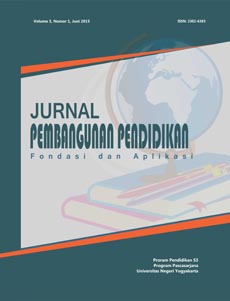Pemanfaatan lingkungan sekitar sebagai sumber belajar terhadap berpikir kreatif siswa
DOI:
https://doi.org/10.21831/jppfa.v7i1.23914Keywords:
Lingkungan sekitar, berpikir kreatif, sumber belajar, learning resources, surrounding environment, creative thinkingAbstract
Penelitian ini bertujuan untuk mengetahui pengaruh pemanfaatan lingkungan sekitar sebagai sumber belajar terhadap berpikir kreatif pada pembelajaran tematik integrative siswa kelas IV SD. Penelitian dilakukan di SDN Warureja 01 dan SDN Warureja 02 Kabupaten Tegal. Instrumen penelitian yang digunakan meliputi observasi, lembar validasi ahli dan lembar tes berpikir kreatif. Jenis penelitian yang digunakan adalah quasi-eksperiment dengan desain pretest-posttest control group design. Uji normalitas dilakukan dengan metode Kolmogorov-Smirnov dan uji homogenitas data menggunakan Box'M test. Data dianalisis dengan pengujian hipotesis yaitu uji beda rata-rata univariat menggunakan independent sample t-test dengan taraf signifikansi 5%. Hasil penelitian menunjukkan bahwa: pemanfaatan lingkungan sekitar sebagai sumber belajar berpengaruh terhadap berpikir kreatif dengan nilai signifikansi 0,037< 0.05.
Abstract
This study aimed to know the Effect of the Surrounding Environment as a Learning Resource on Creative Thinking to the 4th Grade Students of State Elementary Schools. in integrative thematic learning of the fourth grade of State Elementary Schools. The study was conducted at SDN Warureja 01 and SDN Warureja 02 Tegal Regency. The research instruments used included observation, expert validation sheets, and creative thinking test sheets. The type of research used was quasi-experiment with pretest-posttest design nonequivalent control group design. The normality test was done by the Kolmogorov-Smirnov method and homogeneity test using the Box'M test. The Data were analyzed by hypothesis testing beginning with univariate mean difference test using independent sample t-test with a 5% significance level. The results showed that: the utilization of the surrounding environment as a source of learning approach affects the creative thinking, the significance level of 0,037< 0.05.
References
Aryani, Luh, A.A.I.N Marhaeni & W. Suastra. (2013). Pengaruh Pemanfaatan Lingkungan Alam Sekitar Dalam Proses Pembelajaran Terhadap Keterampilan Proses Sains dan Hasil Belajar IPA Kelas V SD Gugus IV Kecamatan Sukasada. Journal Pascasarjana Universitas Pendidikan Ganesa. Vol. 3, No. 1, (pp.1-7).
Bernadi, Resna Maulida Ayu. (2017) Peningkatan Kreativitas Siswa Kelas IV SD Melalui Pembelajaran Tematik Integratif dengan Pendekatan Open-Ended. Jurnal Prima Edukasia. Vol. 5, No.1, (pp.91-101).
Creswell, John W. (2015). Research Design Pendekatan Kualitatif, Kuantitatif, dan Mixed. Yogyakarta: Pustaka Pelajar.
Ellis, A. K. (2010). Teaching and Learning Elementary Social Studies. New York: Pearson Education.
Kosasih, E. (2014). Strategi Belajar dan Pembelajaran Implementasi Kurikulum 2013. Bandung: Yrama Widya.
Kuan Chen Tsai. (2013). Leadership Recipes for Promoting Students"Ÿ Creativity. International Journal of Humanities and Social Science. Vol. 3, No. 5,(pp.1-9).
Laird, S. G., McFarland-Piazza, L., & Allen, S. (2014). Young Children"Ÿs Opportunities For Unstructured Environmental Exploration Of Nature: Links To Adults"Ÿ Experiences In Childhood. International Journal of Early Childhood Environmental Education, Vol. 2 No. 1, (pp.58-77).
Swarat, SU. (2008). What makes a topic interesting? A conceptual and methodology exploration of the undelying dimentions of topic interest. Electronic Journal of Science Education. Vol. 12, No. 2, (pp. 1-26).
Undang-undang Republik Indonesia. Nomor 20 Tahun 2003 tentang Sistem Pendidikan Nasional.
Published
How to Cite
Issue
Section
Citation Check
License
The Authors submitting a manuscript do so on the understanding that if accepted for publication, copyright publishing of the article shall be assigned to Jurnal Pembangunan Pendidikan: Fondasi dan Aplikasi
 | Jurnal Pembangunan Pendidikan: Fondasi dan Aplikasi by https://journal.uny.ac.id/index.php/jppfa is licensed under a Creative Commons Attribution-ShareAlike 4.0 International License. |













